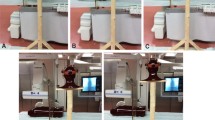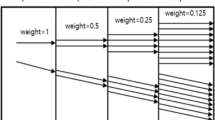Abstract
During interventional cardiological procedures, operators are exposed to patients’ scatter radiation. Therefore, we measured the radiation exposure of the operator’s eyeball, thyroid, and chest wall during angiography. We used the optically stimulated luminescence dosimeter in the anthropomorphic phantom and developed Monte Carlo simulations using the Korean human voxel phantom. At 15 frames/s, the radiation dose of the operator’s right eyeball (RE), left eyeball (LE), thyroid (T), and chest wall (CW) at the femoral artery puncture position (FAPP) with protective equipment (PE) was 0.015, 0.16, 0.012, and 0.014 mGy, respectively. At 7.5 frames/sec, the radiation dose of the operator’s RE, LE, T, and CW at FAPP with PE was 33.33%, 18.75%, 52.94%, and 45.00% lower than that of those at the radial artery puncture position (RAPP), respectively. At 15 frames/s, the radiation dose of the operator’s RE, LE, T, and CW at RAPP without PE was 1.76 times, 2.23 times, 2.76 times, and 2.05 times higher than that of those with PE. Per the simulation results, the absorbed radiation dose of the eye ball, thyroid gland, and myocardium of the heart at FAPP with and without PE under 15 frame/s was 9.68%, 13.04%, 8.33% and 9.98%, 6.00%, 8.82% lower than at RAPP under similar conditions. Effective measures for occupational radiological protection are lower frame rate exposure, increased distance from the X-ray source, and PE use. Radiologist protection in interventional cardiology cannot be handled independently of patient protection, owing to several correlations; thus, reducing the patient dose will reduce the operator dose.



Similar content being viewed by others
Data availability
All data generated or analysed during this study are included in this published article.
Code availability
NA
References
Rajabi AB, Noohi F, Hashemi H, Haghjoo M, Miraftab M, Yaghoobi N, Rastgou F, Malek H, Faghihi H, Firouzabadi H, Asgari S, Rezvan F, Khosravi H, Soroush S, Khabazkhoob M (2015) Ionizing radiation-induced cataract in interventional cardiology staff. Res Cardiovasc Med 4:e25148. https://doi.org/10.5812/cardiovascmed.25148
Kim KP, Miller DL, Balter S, Kleinerman RA, Linet MS, Kwon D, Simon SL (2008) Occupational radiation doses to operators performing cardiac catheterization procedures. Health Phys 94:211–227. https://doi.org/10.1097/01.HP.0000290614.76386.35
Sodhi KS, Krishna S, Saxena AK, Sinha A, Khandelwal N, Lee EY (2015) Clinical application of ‘Justification’and ‘Optimization’principle of ALARA in pediatric CT imaging: How many children can be protected from unnecessary radiation? Eur J Radiol 84:1752–1757. https://doi.org/10.1016/j.ejrad.2015.05.030
Cousins C, Miller DL, Bernardi G, Rehani MM, Schofield P, Vano E, Einstein AJ, Geiger B, Heintz P, Padovani R, Sim KH (2013) ICRP publication 120: radiological protection in cardiology. Ann ICRP 42:1–125. https://doi.org/10.1016/j.icrp.2012.09.001
Andreassi MG, Piccaluga E, Guagliumi G, Del Greco M, Gaita F, Picano E (2016) Occupational health risks in cardiac catheterization laboratory workers. Circ Cardiovasc Interv 9:e003273. https://doi.org/10.1161/CIRCINTERVENTIONS.115.003273
Klein LW, Miller DL, Balter S, Laskey W, Haines D, Norbash A, Matthew AM, James AG (2009) Occupational health hazards in the interventional laboratory: time for a safer environment. Catheter Cardiovasc Interv 20:432–438. https://doi.org/10.1016/j.jvir.2009.04.027
International Commission on Radiological Protection. ICRP Statement on tissue reactions. ICRP web page, https://www.icrp.org/page.asp?id=123. Accessed 15 January 2020.
Stewart FA, Akleyev AV, Hauer-Jensen M, Hendry JH, Kleiman NJ, Macvittie TJ, Aleman BM, Edgar AB, Mabuchi K, Muirhead CR, Shore RE, Wallace WH (2012) ICRP PUBLICATION 118: ICRP Statement on tissue reactions and early and late effects of radiation in normal tissues and organs – threshold doses for tissue reactions in a radiation protection context. Ann ICRP 41:1–322. https://doi.org/10.1016/j.icrp.2012.02.001
Miller DL, Vañó E, Bartal G, Balter S, Dixon R, Padovani R, Schueler B, Cardella JF, Baère TD (2010) Occupational radiation protection in interventional radiology: a joint guideline of the Cardiovascular and Interventional Radiology Society of Europe and the Society of Interventional Radiology. Cardiovasc Inter Rad 33:230–239. https://doi.org/10.1007/s00270-009-9756-7
López PO, Dauer LT, Loose R, Martin CJ, Miller DL, Vañó E, Doruff M, Padovani R, Massera G, Yoder C (2018) ICRP Publication 139: occupational radiological protection in interventional procedures. Ann ICRP 47:1–118. https://doi.org/10.1177/0146645317750356
Kim JS, Lee BK, Ryu DR, Chun KJ, Kwon HS, Nam SR, Di K, Sy L, Jeon JO, Bae JW, Park JS, Ahn Y, Chae JK, Yoon MH, Lee SH, Yoon J, Gwon HC, Choi D, Kwon SM, Roh YH, Cho BR (2020) Occupational radiation exposure in femoral artery approach is higher than radial artery approach during coronary angiography or percutaneous coronary intervention. Sci Rep 10:1–7. https://doi.org/10.1038/s41598-020-62794-2
Lie ØØ, Paulsen GU, Wøhni T (2008) Assessment of effective dose and dose to the lens of the eye for the interventional cardiologist. Radiat Prot Dosim 132:313–318. https://doi.org/10.1093/rpd/ncn296
E Chambers CA, Fetterly K, Holzer R, Paul Lin PJ, Blankenship JC, Balter S, Laskey WK (2011) Radiation safety program for the cardiac catheterization laboratory. Catheter Cardiovasc Interv 77:546–556. https://doi.org/10.1002/ccd.22867
Khong PL, Ringertz H, Donoghue V, Frush D, Rehani M, Appelgate K, Sanchez R (2013) ICRP Publication 121: Radiological protection in paediatric diagnostic and interventional radiology. Ann ICRP 42:1–63. https://doi.org/10.1016/j.icrp.2012.10.001
Rahko PS (2008) Evaluation of the skin-to-heart distance in the standing adult by two-dimensional echocardiography. J Am Soc Echocardiog 21:761–764. https://doi.org/10.1016/j.echo.2007.10.027
Liao LJ, Lo WC, Hsu WL, Cheng PW, Wang CP (2018) Assessment of pain score and specimen adequacy for ultrasound-guided fine-needle aspiration biopsy of thyroid nodules. J Pain Res 11:61–66. https://doi.org/10.2147/JPR.S148088
Maeder M, Verdun FR, Stauffer JC, Ammann P, Rickli H (2005) Radiation exposure and radiation protection in interventional cardiology. Kardiovaskuläre Medizin 8(4):124–132
Acknowledgements
This study was supported by 2016 Research Grant from Kangwon National University (Grant No. 520160248)
Funding
This study was supported by 2016 Research Grant from Kangwon National University (Grant No. 520160248).
Author information
Authors and Affiliations
Contributions
Y-HR and S-RN conceptualised the study and contributed to the final version of the manuscript. S-RN, B-KL, D-RR, KC, K-SL, and NC conducted measurements for phantom study. Y-HR, Y-SY, and H-MP performed simulations for MCNP. J-SK supervised the simulation procedure and B-RC the phantom study.
Corresponding authors
Ethics declarations
Conflict of interest
The authors declare they have no conflict of interests.
Ethical approval
This article does not contain any studies with human participants or animals performed by any of the authors.
Informed consent
For this type of study, informed consent is not required. This study is registered on Kwangwon national university institutional review board under number KNUH-2018‐10-001.
Additional information
Publisher's Note
Springer Nature remains neutral with regard to jurisdictional claims in published maps and institutional affiliations.
Rights and permissions
About this article
Cite this article
Roh, Y., Nam, S., Lee, BK. et al. Radiation exposure of interventional cardiologists during coronary angiography: evaluation by phantom measurement and computer simulation. Phys Eng Sci Med 43, 1279–1287 (2020). https://doi.org/10.1007/s13246-020-00931-x
Received:
Accepted:
Published:
Issue Date:
DOI: https://doi.org/10.1007/s13246-020-00931-x




